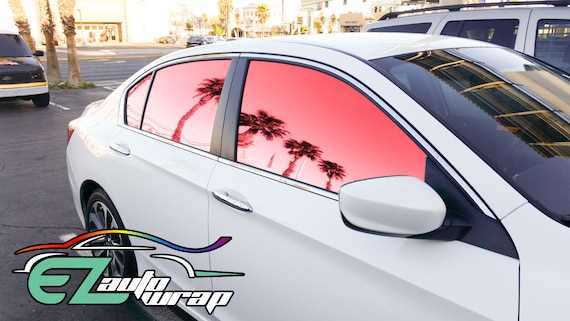Last Updated on February 24, 2024 by Vadym

Window tinting is a popular way to enhance the look and functionality of a vehicle. It can provide protection from harmful UV rays, reduce glare, and increase privacy. However, when it comes to choosing the color of window tint, there are certain legal considerations that need to be taken into account.
One common question that arises is whether red window tint is legal. Red window tint can undoubtedly give a vehicle a unique and eye-catching appearance. It is often associated with a sporty or aggressive look. However, the legality of this tint color can vary depending on the jurisdiction.
In many states and countries, red window tint is strictly prohibited. The reason for this is that red is a color often associated with emergency vehicles, such as fire trucks and ambulances. Red window tint can create confusion on the road and may prevent other drivers from identifying emergency vehicles accurately.
While red window tint may be prohibited in most areas, there may be some exceptions. It is essential to check the specific traffic laws and regulations in your jurisdiction to determine whether red window tint is legal. Failure to comply with these laws can result in fines, vehicle inspections, and even license suspensions.
Understanding Red Window Tint
Red window tint is a type of automotive window film that has a red color. It is used to give vehicles a unique, stylish appearance and to provide additional privacy and protection.
Red window tint works by blocking or reducing the amount of light that can enter a vehicle through its windows. This can help to reduce glare and heat, making the interior of the vehicle more comfortable, especially during hot summer months.
In addition to its aesthetic appeal, red window tint may also offer some benefits in terms of safety. By reducing glare and heat, it can improve visibility and reduce the risk of accidents caused by distracting sunlight. It can also help to protect the interior of the vehicle from fading and cracking due to UV rays.
However, it is important to note that the use of red window tint may be subject to certain laws and regulations. While some jurisdictions allow the use of red window tint to a certain extent, others may prohibit it altogether or only allow tinting of a specific shade or darkness.
Before applying red window tint to your vehicle, it is crucial to research and familiarize yourself with the local laws and regulations in your area. This can help you avoid potential fines or other legal consequences related to illegal window tinting.
If you are considering red window tint for your vehicle, it is also recommended to consult with a professional window tinting service. They can provide guidance on the appropriate shade or darkness of red tint that is legal and safe for your specific vehicle and jurisdiction.
| Benefits of Red Window Tint | Legal Considerations |
|---|---|
|
|
Legality of Red Window Tint
Window tinting is a popular modification for vehicles that offers a range of benefits, including increased privacy, reduced glare, and protection from harmful UV rays. However, when it comes to tinting your vehicle’s windows with red tint, there are specific laws and regulations that must be followed.
Red window tint is generally not legal for use on the front windshield or front side windows of a vehicle. This is because red tint can significantly obscure the driver’s view and may obstruct their ability to see traffic signals and road signs, leading to potentially dangerous situations on the road.
However, regulations regarding red window tint may vary from jurisdiction to jurisdiction. Some states or countries may permit the use of red tint on rear windows or rear side windows, as it is less likely to interfere with the driver’s visibility. It’s important to research and understand the specific laws in your area before applying any red tint to your vehicle’s windows.
It’s also worth noting that even if red window tint is technically allowed, it may still be subject to restrictions or limitations. For example, some jurisdictions may require that vehicles with red window tint have additional side mirrors for increased visibility. Others may impose strict limits on the darkness of the tint to ensure that it does not reduce visibility to unsafe levels.
Ultimately, it is the responsibility of the vehicle owner to ensure that their window tint complies with all applicable laws and regulations. Failure to do so can result in fines, vehicle impoundment, or other legal consequences. It’s always a good idea to consult with local authorities or a professional window tinting service to ensure that you are in compliance with the law.
Red Window Tint Laws by State
Many states in the United States have specific laws and regulations regarding window tinting, including the use of red tint. It is important to understand the laws in your state before installing red window tint on your vehicle. Here is an overview of red window tint laws by state:
- Alabama: Red window tint is not allowed on the front windshield or front side windows.
- Alaska: Red window tint is not allowed on the front side windows.
- Arizona: Red window tint is not allowed on the front windshield or front side windows.
- Arkansas: Red window tint is not allowed on the front windshield or front side windows.
- California: Red window tint is not allowed on the front windshield or front side windows.
- Colorado: Red window tint is not allowed on the front windshield or front side windows.
- Connecticut: Red window tint is not allowed on the front windshield or front side windows.
- Delaware: Red window tint is not allowed on the front windshield or front side windows.
- Florida: Red window tint is not allowed on the windshield, front side windows, or rear window.
- Georgia: Red window tint is not allowed on the front windshield or front side windows.
Please note that the above information is just a sample of red window tint laws in some states. It is always best to check with your local Department of Motor Vehicles or law enforcement agency for the most up-to-date and accurate information regarding window tinting laws in your state.
Consequences of Using Red Window Tint
Using red window tint on your vehicle can have a number of consequences, both legal and practical.
Firstly, it is important to note that using red window tint may be illegal in many jurisdictions. Laws regarding window tint vary from place to place, but generally, tint that obstructs or reduces visibility is not allowed. Red window tint, in particular, can impair the driver’s ability to see clearly, especially at night or in low light conditions. This can increase the risk of accidents and make it difficult for other drivers to see your vehicle.
In addition to the legal implications, using red window tint can also have practical consequences. Red tint can significantly reduce the amount of natural light that enters the vehicle, making it harder to see objects and obstacles on the road. This can create safety hazards and increase the chances of getting involved in an accident. Moreover, red tint can also affect the visibility of traffic signals and road signs, further compromising safety on the road.
Furthermore, red window tint may attract unnecessary attention from law enforcement officers. Even if it is legal in your area, driving a vehicle with red window tint may still result in being pulled over and questioned by authorities. This can lead to delays, fines, and other inconveniences.
Lastly, it is worth mentioning that using red window tint can negatively impact the resale value of your vehicle. Most buyers prefer vehicles with standard, legal window tint or no tint at all. Having red tint may limit the pool of potential buyers and make it more difficult to sell your vehicle for a desirable price.
Overall, using red window tint can have legal, practical, and financial consequences. It is essential to familiarize yourself with the specific laws and regulations in your area before considering using red window tint or any other tint that may obstruct visibility on your vehicle.
Alternatives to Red Window Tint

If red window tint is not legal in your location or you simply prefer not to use it, there are alternative options available for achieving a similar effect:
1. Colored Window Film: Instead of using red window tint, you can opt for colored window film. Colored window film comes in a variety of shades and can be applied to your windows to achieve the desired color effect. This allows you to customize the look of your vehicle while still complying with the legal regulations.
2. Window Decals: Window decals are another option for adding color and style to your windows. You can choose from a wide range of designs and colors to create a unique look. Window decals are relatively easy to apply and can be easily removed if desired.
3. Window Shades: Window shades or blinds are yet another alternative to red window tint. These can be installed on the inside of your vehicle’s windows and can be adjusted to provide shade and privacy. Window shades come in various colors and patterns, allowing you to personalize the appearance of your vehicle.
4. Window Paint: If you are looking for a more permanent solution, window paint is an option to consider. With window paint, you can create custom designs and colors on your windows. However, it’s important to check the legality of using window paint in your area, as some regions may have restrictions on this type of modification.
5. Window Curtains: For those who prioritize privacy, window curtains can be a suitable alternative. These can be hung on the inside of your vehicle’s windows and can be drawn open or closed as needed. Window curtains can be found in different colors and materials, allowing you to find a style that matches your preference.
Remember to always check the specific laws and regulations regarding window tint in your area before making any modifications to your vehicle’s windows.
